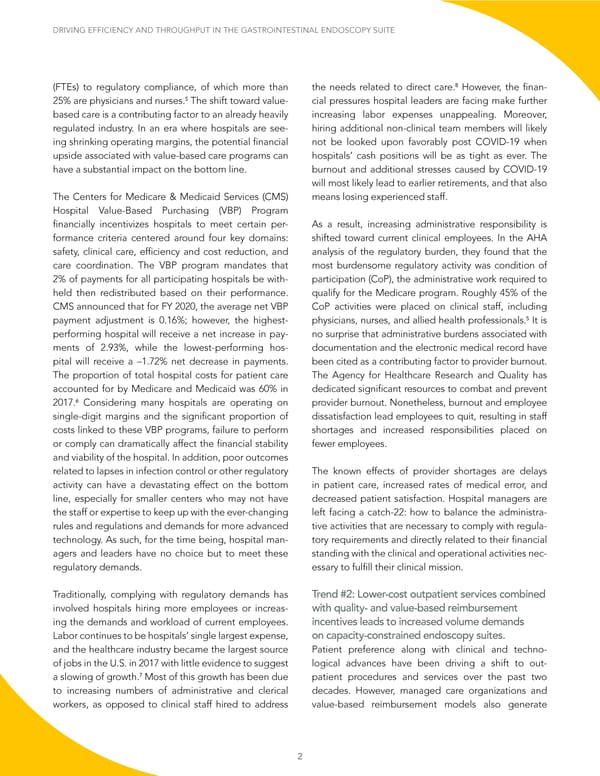DRIVING EFFICIENCY AND THROUGHPUT IN THE GASTROINTESTINAL ENDOSCOPY SUITE 8 (FTEs) to regulatory compliance, of which more than the needs related to direct care. However, the finan- 5 25% are physicians and nurses. The shift toward value- cial pressures hospital leaders are facing make further based care is a contributing factor to an already heavily increasing labor expenses unappealing. Moreover, regulated industry. In an era where hospitals are see- hiring additional non-clinical team members will likely ing shrinking operating margins, the potential financial not be looked upon favorably post COVID-19 when upside associated with value-based care programs can hospitals’ cash positions will be as tight as ever. The have a substantial impact on the bottom line. burnout and additional stresses caused by COVID-19 will most likely lead to earlier retirements, and that also The Centers for Medicare & Medicaid Services (CMS) means losing experienced staff. Hospital Value-Based Purchasing (VBP) Program financially incentivizes hospitals to meet certain per- As a result, increasing administrative responsibility is formance criteria centered around four key domains: shifted toward current clinical employees. In the AHA safety, clinical care, efficiency and cost reduction, and analysis of the regulatory burden, they found that the care coordination. The VBP program mandates that most burdensome regulatory activity was condition of 2% of payments for all participating hospitals be with- participation (CoP), the administrative work required to held then redistributed based on their performance. qualify for the Medicare program. Roughly 45% of the CMS announced that for FY 2020, the average net VBP CoP activities were placed on clinical staff, including 5 payment adjustment is 0.16%; however, the highest- physicians, nurses, and allied health professionals. It is performing hospital will receive a net increase in pay- no surprise that administrative burdens associated with ments of 2.93%, while the lowest-performing hos- documentation and the electronic medical record have pital will receive a –1.72% net decrease in payments. been cited as a contributing factor to provider burnout. The proportion of total hospital costs for patient care The Agency for Healthcare Research and Quality has accounted for by Medicare and Medicaid was 60% in dedicated significant resources to combat and prevent 6 2017. Considering many hospitals are operating on provider burnout. Nonetheless, burnout and employee single-digit margins and the significant proportion of dissatisfaction lead employees to quit, resulting in staff costs linked to these VBP programs, failure to perform shortages and increased responsibilities placed on or comply can dramatically affect the financial stability fewer employees. and viability of the hospital. In addition, poor outcomes related to lapses in infection control or other regulatory The known effects of provider shortages are delays activity can have a devastating effect on the bottom in patient care, increased rates of medical error, and line, especially for smaller centers who may not have decreased patient satisfaction. Hospital managers are the staff or expertise to keep up with the ever-changing left facing a catch-22: how to balance the administra- rules and regulations and demands for more advanced tive activities that are necessary to comply with regula- technology. As such, for the time being, hospital man- tory requirements and directly related to their financial agers and leaders have no choice but to meet these standing with the clinical and operational activities nec- regulatory demands. essary to fulfill their clinical mission. Traditionally, complying with regulatory demands has Trend #2: Lower-cost outpatient services combined involved hospitals hiring more employees or increas- with quality- and value-based reimbursement ing the demands and workload of current employees. incentives leads to increased volume demands Labor continues to be hospitals’ single largest expense, on capacity-constrained endoscopy suites. and the healthcare industry became the largest source Patient preference along with clinical and techno- of jobs in the U.S. in 2017 with little evidence to suggest logical advances have been driving a shift to out- 7 a slowing of growth. Most of this growth has been due patient procedures and services over the past two to increasing numbers of administrative and clerical decades. However, managed care organizations and workers, as opposed to clinical staff hired to address value-based reimbursement models also generate 2
 Driving Efficiency & Throughput Page 2 Page 4
Driving Efficiency & Throughput Page 2 Page 4